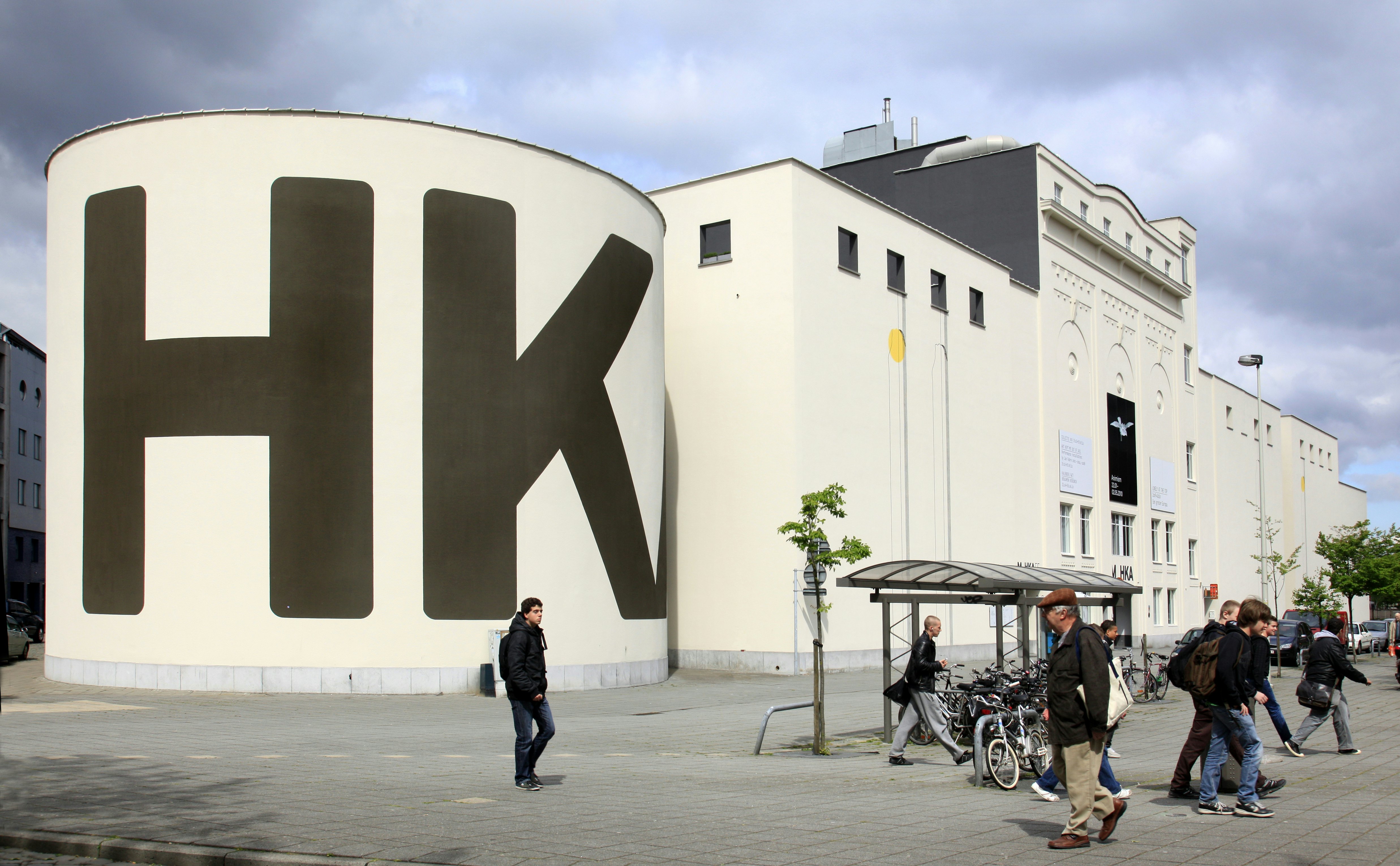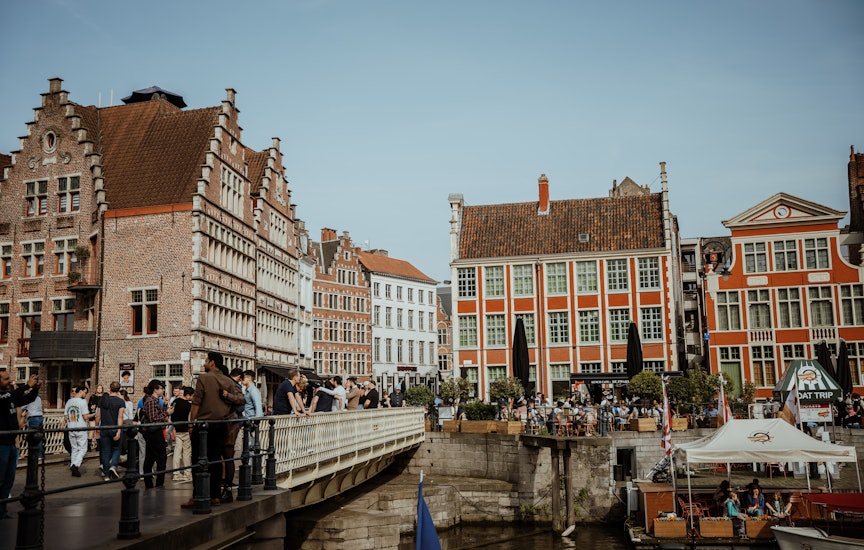

Museum aan de Stroom on the waterfront. siraanamwong / Getty Images
It should come as no surprise that Antwerp’s cultural cred punches way above its ‘second capital’ status. It was, back in the 16th-century, one of the world’s greatest and richest cities and one where merchants and diplomats, sailors and artisans mixed and mingled. Today’s multicultural city is as open and fluid as ever, its mix of beautiful Baroque townhouses, Jugenstil districts and edgily regenerated industrial areas providing a moody and evocative backdrop to a flourishing creative milieu and a flourishing contemporary art, fashion and music scene.

Gallery going
The canvasses of Luc Tuymans – one of the world’s most well-respected contemporary artists, and a life-long resident of Antwerp – filter piercingly direct, occasionally shocking ‘found’ photographic images – from newspapers, TV grabs and various other sources – through a swimmy, painterly blur rendered in a palette of earthy blues, greys and browns. His debt to the Flemish Masters – in particular Ghent’s Jan van Eyck – is obvious, so to is the influence of his hometown’s distinctive landscape, its North Sea sky, and perhaps also its ever outward gaze. While his work is part of collections at MoMA and the like, he still shows at Zeno X, Antwerp’s leading contemporary gallery. This is a favourite first stop for contemporary art fans, with other leading Belgians, like Michaël Borremans, as well as a number of international superstars like South African Marlene Dumas also part of their regular stable. Other long standing galleries like Annie Gentils and De Zwarte Panter and new comers Ingrid Deuss and Gallery Sofie Van de Velde are also must-sees, and show both Belgian and international artists. The newly refurbished Museum of Contemporary Art Antwerp (MHKA) has a strong Flemish collection, not to mention a beautiful bookshop designed by Antwerpen designer and all-round style doyen, Axel Vervoordt. Far beyond the scope of a bookshop though is Vervoordt’s latest project, Kanaal, a new Scheldt'-side complex in a former 19th-century distillery that incorporates a number exhibition venues, as well as shops, offices, workshops, apartments and a destination restaurant, along with permanent art works by Anish Kapoor, Marina Abramović and James Turrell.
Looking forward, looking up
Antwerp’s architectural heritage is what might be called textured, rather than historically pristine, with a well-preserved Baroque centre and joyfully decorative Jugenstil inner neighbourhoods like Zurenborg, along with many late 20th-century and contemporary buildings throughout, a result of a serious WWII bombing. It’s also now known for its interesting, daring contemporary buildings, with the Museum aan de Stroom (MAS) – a deconstructed sixty-metre high tower in the waterfront warehouse district of Eilandje – setting the standard in 2011. Inside, you’ll find a fluid-flowing collection of objects that form a fascinating narrative exploring Antwerp’s mercantile and maritime history and the complex, ever shifting politics of both the city and of Belgium itself. (No big deal if you’ve yet to come across a Luc Tuymans, there’s one here, but a tip: his massive mosaic artwork Dead Skull is only visible from the 5th floor up.) The two Michelin-starred restaurant ‘t Zilte sits on its top floor, known for its stellar local produce and vivid plating, as well as its panoramic views across the city’s spires and down the Scheldt' to the working docks.
Black on black
Long a textiles hub, Antwerp became the thinking person’s fashion capital with the advent of the edgy deconstructionist Antwerp Six in the 80s, all six designers were graduates of the city’s still flourishing Royal Academy fashion course. MoMU, Antwerp’s beloved fashion museum, often highlights their work, but while it’s closed for renovation until 2020, catch its travelling show Margiela, the Hermes Years (Margiela is another famous Royal Academy alumi) in Paris, or head to the flagship shops of Dries van Noten or Ann Demeulemeester for current pieces that will one day be museum-worthy too.
While the Antwerp Six were exploding the way curators, architects and art directors dressed in the 80s, Belgium’s music scene was also changing the way everyone danced. Growing out of the lush, lulling Popcorn sound of the 70s, the country, with no strict closing hours, is often credited for not entirely intentionally inventing the rave. Whether or not that’s the case, it was definitely responsible for electronic body music and Belgian new beat and club life in Antwerp continues to be rich, varied and pretty much a 24-hour concern. Veteran clubs like Red Light District’s Cafe d'Anvers are still going strong, a rota of insanely popular festivals and edgier venues like Pekfabriek and Bar Venetie springing up in hipster haunt Borgerhout.

Creative spirits
The upcoming Antwerp Baroque 2018 festival celebrates both Peter Paul Rubens’ painterly legacy and the city’s 17th-century glory days alongside the work of the city’s contemporary artists, including Luc Tuymans and conceptualist Jan Fabre, who all share the theatrical emotionality and dark, evocative Flemish palette of the era. Another new treat in store at the evocative Rubenhuis museum is Tintoretto’s The Angel Foretelling Saint Catherine of Alexandria of Her Martyrdom – from the former collection of David Bowie; Rubens was greatly influenced by great Venetian painter and its new private owner thought that Antwerp was its rightful home. It’s joined on loan at the museum by another Tintoretto, Portrait of a Lady and Her Daughter, an extraordinarily pretty double portrait, that had been overpainted and was only uncovered by x-ray in 1948. But perhaps most significantly of all, a newly restored self-portrait of the man himself, with piercing gaze and sensual lips, is back with pride of place at his one time home and studio.
Finally, no visit to the city is complete without seeing one of its oldest museums. A discrete presence on one of the historic centre’s most picturesque squares, the Plantin-Moretus Museum is a sublimely giddy making experience for anyone in love with the printed word. It’s also a reminder of Antwerp’s longstanding status as a diverse, tolerant and boundary pushing metropolis and the 16th-century merchants and artisans who helped make it that way. Two of the oldest printing presses in the world can be found here, dating back to the time when this was a printing workshop and family home of master printer, humanist and collector, Christophe Plantin, and later his son-in-law Jan Moretus. Their living quarters are lined with Rubens’ paintings, drawings and prints, there’s the original lead type of the Garamond typeface made by Garamond himself, and cases filled with ancient manuscripts, including a Gutenberg bible.















